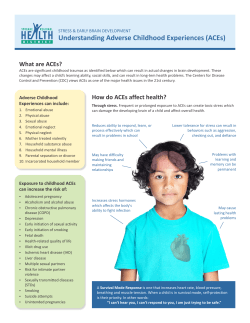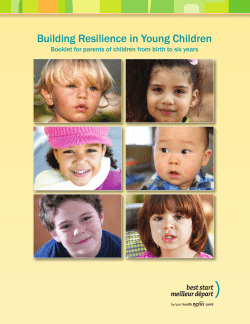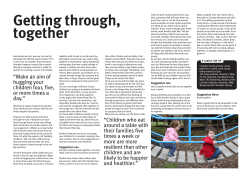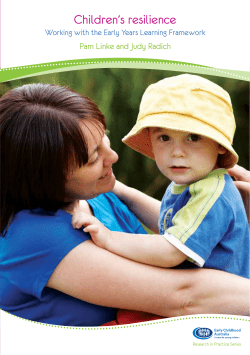
Document 203702
Proceedings of the 12th International Coral Reef Symposium, Cairns, Australia, 9-13 July 2012 19A Human impacts on coral reefs: general session Assessing community resilience to climate change 1 2 3 Karen Vella , Allan Dale , Alison Cottrell , and M. Gooch 3 1 Griffith School of Environment, Griffith University, Parklands Drive, Southport, Q 4222, Australia 2 The Cairns Institute, James Cook University, Cairns, Q 4870, Australia 3 The Cairns Institute, James Cook University, Townsville, Q 4811, Australia Corresponding author: k.vella@griffith.edu.au Abstract. Settlements and communities in the Great Barrier Reef (GBR) are highly vulnerable to climate change and face an uncertain social, economic and environmental future. The concept of community resilience is gaining momentum as stakeholders and institutions seek to better understand the social, economic and governance factors which affect community capacity to adapt in the face of climate change. This paper defines a framework to benchmark community resilience and applies it to a case study in the Wet Tropics in tropical Queensland within the GBR catchment. It finds that rural, indigenous and some urban populations are highly vulnerable and sensitive to climate change, particularly in terms of economic vitality, community knowledge, aspirations and capacity for adaptation. Without early and substantive action, this could result in declining social and economic wellbeing and natural resource health. Capacity to manage the possible shocks associated with the impacts of climate change and extreme climatic events is emerging and needs to be carefully fostered and further developed to achieve broader community resilience outcomes. Better information about what actions, policies and arrangements build community resilience and mobilise adaptive capacity in the face of climate change is needed. Key words: Climate change adaptation, monitoring and evaluation, Great Barrier Reef Introduction The Great Barrier Reef (GBR) is widely recognised for its outstanding ecological, economic, social and cultural values (Great Barrier Reef Marine park Authority, 2009). These values depend on an intact, healthy and resilient ecosystem. Climate change poses a serious risk to this system. Much of the thinking about climate change mitigation and adaptation in the GBR has focused on biophysical dimensions reef resilience. Building the resilience of the GBR in the face of climate change depends on the emergence of strong resilience within the communities that depend on and manage the reefs key natural assets. GBR communities are themselves highly vulnerable socially and economically to climate change. Government, industry, and community stakeholders need to know which actions, policies and arrangements build and support social resilience for GBR resilience. In this paper we describe an approach to benchmark community resilience which can be integrated into regular environmental assessments and regional condition and trend reporting. This approach can support community, industry and government stakeholders to identify priorities to build social resilience for reef management. Material and Methods Our research sought to develop, in a collaborative manner, a pragmatic approach to measure and monitor regional community resilience that government agencies, NRM bodies and community stakeholders could apply to support adaptation to climate change. More specifically the aim was to provide stakeholders in tropical Queensland (Fig 1.) with a framework and method to develop integrated and longitudinal information about the health and resilience of communities vulnerable to climate change, to support greater understanding about which actions, policies and arrangements build and support community resilience and hence community adaptive capacity. The research employed the following methods: 1). Review recent social resilience research undertaken within the region. Content analysis of reports generated from a major four year project conducted at three nested scales was undertaken to identify key findings, problems and limitations with the approaches taken at each of the three scales; 2). Identify and map the multidisciplinary knowledge on resilience. Reviewed bodies of literature were analysed according to the ways in which scholars use ‘resilience’, ‘social resilience’, ‘community resilience’ and adaptive capacity in different contexts and for different purposes; Proceedings of the 12th International Coral Reef Symposium, Cairns, Australia, 9-13 July 2012 19A Human impacts on coral reefs: general session 3). Develop a regional indicator framework. This was constructed by synthesising information and insights gained through Steps 1 and 2; 4). End users review and refine the proposed pilot regional indicator framework. Several meetings were held with key end users including the Wet Tropics Management Agency (WTMA), the Great Barrier Reef Marine Park Authority (GBRMPA), Terrain NRM, Cape York Peninsula NRM, Northern Gulf NRM, Torres Strait Regional Authority, FNQ Regional Organisation of Councils, the Department of Infrastructure and Planning, Cairns Regional Council, ARUP; Association of Marine Park Tourism Operators (AMPTO); Tourism Tropical North Queensland (TTNQ); Cairns Marine; CAFNEC; and Regional Development Australia between October 2010 and March 2011 to stimulate discussions and refine specific components of the framework; 5). Trial the framework of indicators in state-of-theregion reporting in the Wet Tropics sub-region (Fig. 1). Small groups of community and research experts appraised the data in terms of social resilience and produced a Cairns Assessment Report; 6). Build a collaborative alliance of management agencies within the region to consider the long-term strategy for adaptive management of community resilience; and 7). Map resilience in relation to biodiversity conservation. Figure 1: Study location in tropical Queensland. The Wet Tropics sub-region is highlighted on the eastern portion of the study area. Results Previous social resilience research in the region. Previous social resilience research in tropical Queensland produced frameworks and indicators to measure and monitor social resilience. These was limited when considered in terms of stakeholder needs for adaptive environmental management in the face of climate change at the community scale and this highlighted a number of conditions that the research project would need to achieve. In summary, these are that the framework of indicators to define and monitor community resilience would need to be embedded within stakeholder planning and policy approaches to adaptively monitor the relationship between policy and outcomes. They would also need to include contextual vulnerability factors so that stakeholders could identify planning priorities to building community resilience. The assessment needed be mindful of the limited resources and data available to management agencies. It also needed to translate information collected against indicators into an overall assessment of social resilience. In other words, the framework needed to deliver a holistic picture of community resilience based on frugal synthesis into 3-6 integrated indicator sets for modeling, prediction and proactive planning. Furthermore, the assessment also needed to and bring expert and local stakeholder knowledge together in a lines-of-evidence approach to support the assessment of community resilience and to refine the framework and approach. The multidisciplinary knowledge on resilience In general, understandings of social-ecological resilience includes concepts of resisting change (Holling, 1973; Miletti, 1999; Timmerman, 1981), bouncing back (Walker et. al., 2004), or transforming (Kirmayer et al 2009; Opstal, 2007; Paton and Johnston, 2006) in response to environmental or social perturbations, or even a combination of these (Kirmayer et. al., 2009; UN/ISDR, 2002). Resilience is also viewed as being transformative and adaptive; as a process leading to an end state (Kirmayer et. al. 2009, Norris et al 2008). Vulnerability and sustainability are further related concepts. Community resilience is described differently in various studies and defined more loosely (Kulig, 2000) and there is limited empirical evidence to inform understandings about community resilience. In general, descriptions of community resilience take three different forms: a) resistance: which refers to the ability of a community to absorb perturbation (Geis, 2000); b) recovery: which focuses on the speed and ability to recover from the stressors (Adger, 2000; Breton, 2001); and c) creativity: which addresses the ability of a social system to maintain a constant process of creating and recreating, so that the community not only responds to adversity, but in doing so, reaches a higher level of functioning (Kulig, 1996; Kulig and Hanson, 1996). In the context of disasters, Norris et al (2008) argue Proceedings of the 12th International Coral Reef Symposium, Cairns, Australia, 9-13 July 2012 19A Human impacts on coral reefs: general session that community resilience involves a set of adaptive capacities and it is a strategy for promoting effective disaster readiness and response, maintaining community sustainability, a view also shared by Berkes (2007). The review highlighted that community resilience can be assessed at the macro, sociological level through proxy indicators, such as economic growth and structure, equitable distribution of income and assets within populations, demographic change, and institutional change, and information about individual capacity to cope, grow or transform. Building an understanding of community resilience to climate change requires integrating multiple kinds of qualitative and quantitative data coupled with indicators from several levels within a community, preferably using a conceptual theoretical model, to collate, triangulate and interpret findings and gauge the relative strength of relationships within data. A framework for state-of-the-region reporting The outcome of steps 2-4 was a simple framework of four basic attributes to track and measure community resilience. These attributes are namely: 1). Economic viability - The economic health of a community, inclusive of for example, income levels and disparities, resource dependencies and economic vulnerability; 2). Community vitality - The social health of a community, inclusive of for example, physical health, community wellbeing and dissatisfaction, service access, incarceration rates, etc; 3). Aspirations and capacity - The cohesion and diversity of people’s aspirations for the future and the skills and capacities available to turn these aspirations into action; and 4). Institutional governance systems - The effectiveness of decision-making systems including the connectivity between different parts of the system, the effective use of diverse knowledge in decisionmaking, and the capacity to deliver effective action. This framework provides the basic substantive structure to assess and monitor community resilience (Fig. 2). Other essential components of the community resilience framework, however, must also include the integration of biophysical monitoring, climate risk assessment, and adaptive planning arrangements. Each attribute is further described by a limited set of pressure-state and trend indicators. The aim was to select the fewest number of indicators for each attribute that would still allow decision makers to monitor social resilience over time. The indicators were reviewed by the key end users, refined by the research team, and together the research team and end users complied relevant data against each indicator using a lines-of-evidence approach in the Wet Tropics Trial. This was reviewed by four small groups of community (including government and nongovernment members) and research experts (across fields of social, economic and governance research) and separate groups were convened to assess the resilience of each attribute using an index tool (Table 1). Each expert group appraised the data collected, added additional expert knowledge to fill data gaps, recorded data gaps and limitations and assessed the resilience of current conditions for each attribute. Results were standardised using the 5-point index scale of community resilience. The research team compiled these assessments to produce the Wet Tropics Pilot Assessment of Community Resilience. Figure 2: Framework to design, implement and monitor community resilience (Dale et al. 2011). Index Rating 5 4 3 2 Decision Rule The relevant community will easily mitigate and adapt to the most severe impacts of climate change and extreme climatic events, maintaining or improving their economic and social wellbeing and the health of their natural resource base over time. The relevant community will make some progress on mitigation and accommodate the most severe impacts of climate change and extreme climatic events, maintaining their economic and social wellbeing and the health of their natural resource base over time. The relevant community will suffer some shocks associated with the most severe impacts of climate change and extreme climatic events, taking considerable time and investment to adjust to secure their economic and social wellbeing and natural resource base. The relevant community will be seriously Proceedings of the 12th International Coral Reef Symposium, Cairns, Australia, 9-13 July 2012 19A Human impacts on coral reefs: general session 1 impacted by the most significant impacts of climate change and extreme climatic events, resulting in declining social and economic wellbeing and natural resource health. The relevant community will be irreversibly impacted by the most severe impacts of climate change and extreme climatic events, with both social and economic wellbeing and natural resource health unlikely to recover. Community vitality Reasonable with some vulnerable sectors Governance Improving in some key areas Table 1: Index scale of community resilience to standardize assessments using available lines-of evidence for each attribute (from Dale et al, 2011). Community resilience in the Wet Tropics sub-region The results of the community resilience assessment are highly summarised into Table 2. Overall the assessment found that (a) rural, indigenous and some urban populations are highly vulnerable and sensitive to climate change, particularly in terms of economic vitality, community knowledge, aspirations and capacity for adaptation; (b) without early and substantive action, this could result in declining social and economic wellbeing and natural resource health; (c) capacity to manage the possible shocks associated with the impacts of climate change and extreme climatic events is emerging and needs to be carefully fostered and further developed to achieve broader community resilience outcomes. Attribute Finding Pressure, state and trend summary Economic Viability Vulnerable in the face of climate change - Largest assets to the economy are natural assets for the base industries of agriculture and tourism - Economy is fossil fuel dependent - Some sectors are economically very marginalised - Low skilled workforce - Declining business and tourism confidence - Construction boom and bust cycles - Lack of detailed recent modelling. - Low levels of awareness and of concern about climate change - Poor institutional foundations for awareness and education - Education and knowledge about climate change low and problematic in vulnerable sectors. - Skills level for adaptation generally week, especially at an enterprise level. - Evidence of growing Community knowledge, aspirations and capacity Vulnerable in the face of climate change aspirations of sustainability but limited cohesive investment in leadership and complex problem solving. - Information base needs improving. - Demographic instability and limited experience of extreme events - Health vulnerable and exacerbated by service provision - Physical and mental health issues. - Health, justice and social disparities. - Improved emergency response in urban areas. - Emergency infrastructure vulnerable. - Difficult to assess wellbeing, happiness and service provision - Good capacity in economic and natural resource sectors and emerging capacity in local government sector. - Social and Indigenous sector lack capacity for effective decision making in general and for climate change in particular. - Overarching framework for adaptive planning emerging but vulnerable. - Availability of integrated knowledge sets for adaptive planning an issue. Table 2: A summary of the community resilience assessment. Discussion Regional and remote settlements and communities in the GBR are among Australia’s most vulnerable in the face of climate change (CSIRO and BOM 2007). This creates the potential for increased uncertainty and there is a need to be encouraging community adaptive capacity and resilience to cope with change and assist with the adaptation of management of natural resources and biodiversity under future climate. Long-term approaches to building community resilience require benchmarking and regular monitoring to help track the state and trend of key attributes and overall resilience over time. However, owing to resource and time limitations, consistent information and time-series data are not readily available to monitor state and trend clearly or in full detail at any one point in time. While the available data sets will hopefully improve over time, decision-makers require simple solutions to deliver targeted information immediately and within Proceedings of the 12th International Coral Reef Symposium, Cairns, Australia, 9-13 July 2012 19A Human impacts on coral reefs: general session available resource and data limitations. The framework here seeks to operationalize concepts of community resilience for enhanced adaptive planning by integrating a combination of existing monitoring information, specific studies, proxy information, stakeholder and expert knowledge to assess pressure, state and trend directions for key resilience attributes. Importantly the assessment process is simple and embedded within stakeholder processes to support adaptive planning and policy. Application in the Wet Tropics shows that communities here are highly vulnerable and sensitive to climate change, particularly in terms of economic vitality and community knowledge aspirations. This highlights opportunities for stakeholders to invest early in substantive policy to build community capacity and avoid declining social and economic wellbeing and natural resource health. The analysis also highlights emerging community capacity which can be built upon to achieve community resilience outcomes. Acknowledgement This research was funded by the Australian Government’s Transition Program for the Marine and Tropical Sciences Research Facility through the Reef and Rainforest Research Centre. Helen Boon, Bob Stevenson, David King and Hillary Whitehouse from James Cook University, and Petina Pert and Rosemary Hill from CSIRO were also involved in the broader research. The following key community stakeholders have also been involved in the process: the Wet Tropics Management Agency (WTMA); the Great Barrier Reef Marine Park Authority (GBRMPA); Terrain NRM; Cape York Peninsula NRM; Northern Gulf NRM; Torres Strait Regional Authority; FNQ Regional Organisation of Councils; the Department of Infrastructure and Planning; Cairns Regional Council; ARUP; AMPTO; TTNQ; Cairns Marine; CAFNEC; and Regional Development Australia. We have additionally drawn on the expertise of Bill Cummings, Marg Darveniza, Anita Egginton, and Steve Sutton. We also thank and acknowledge three previous MTSRF Projects which provided intellectual foundations and paved the way for new thinking about community resilience. References Adger, W.N. (2000) ‘Social and ecological resilience; are they related?’ Progress in Human Geography. 24(3): 347–364. Berkes, F. (2007) Understanding uncertainty and reducing vulnerability: Lessons from resilience thinking. Natural Hazards, 41: 283–295. CSIRO and BOM (2007) Climate change in Australia: Technical Report 2007, CSIRO, Melbourne. Dale A, Vella K, Cottrell A, Pert P, Stephenson B, King D, Boon H, Whitehouse H, Hill R, Babacan H, Thomas M, and Gooch M. (2011) Conceptualising, Evaluating and Reporting Social Resilience in Vulnerable Regional and Remote Communities Facing Climate Change in Tropical Queensland: Marine and Tropical Sciences Research Facility Transition Project Final Report, Reef and Rainforest Research Centre, Cairns. Geis, D. E. (2000) By Design: The disaster resistant and quality of life community. Natural Hazards Review 1(3):23. Great Barrier Reef Marine Park Authority (2009) Great Barrier Reef Outlook Report, Australian Government, Townsville. Holling, C. S. (1973) Resilience and Stability of Ecological Systems. Annual Review of Ecology and Systematics 4(1):1-23. Kirmayer, K. L., Whitley, R., Dandeneau, S. F., and Isaac, C. (2009) Community Resilience: Models, Metaphors and Measures. Journal of Aboriginal Health November 2009:62-117. Kulig J. (2000) Community resiliency: the potential for community health nursing theory development. Public Health Nursing Volume 17 pp 374-385. Kulig, J. (1996) Surviving and thriving in the Crowsnest Pass. University of Lethbridge, Regional Center of Health Promotion and Community Studies, Lethbridge, AB. Kulig, J., and Hanson, L. (1996) Discussion and expansion of the concept of resiliency: Summary of think tank. University of Lethbridge, Regional Center of Health Promotion and Community Studies, Lethbridge, AB. Mileti, D. S. (1999) Disasters by design: A Reassessment of Natural Hazards in the United States. Joseph Henry Press, Washington D.C. Norris, F.H. Stevens, S.P. Pfefferbaum, B. Wyche, K.F. and Pfefferbaum, R.L. (2008) Community resilience as a metaphor, theory, set of capacities, and strategy for disaster readiness. American Journal of Community Psychology, 41: 127–150. Opstal, D. van (2007) The Resilient Economy: Integrating Competitiveness and Security. Council on Competitiveness. Www.tisp.org/index.cfm?pk=download&id=11018&pid=10261 Paton, D. and Johnston, D. (2006) Disaster Resilience: An integrated approach. Charles C. Thomas Publisher Ltd., Springfield. Timmerman, P. (1981) Vulnerability, resilience and the collapse of society: a review of models and possible climatic adaptations. Institute for Environmental Studies, University of Toronto, Canada. UN/ISDR (2002) Living with risk: a global review of disaster risk reduction initiatives. Preliminary version prepared as an interagency effort co-ordinated by the ISDR Secretariat, Geneva, Switzerland. Walker, B. Holling, C. S. Carpenter, S. R. and Kinzig, A. (2004) Resilience, adaptability and transformability in social–ecological systems. Ecology and Society 9(2): 5. [online] URL: http://www.ecologyandsociety.org/vol9/iss2/art5
© Copyright 2025









